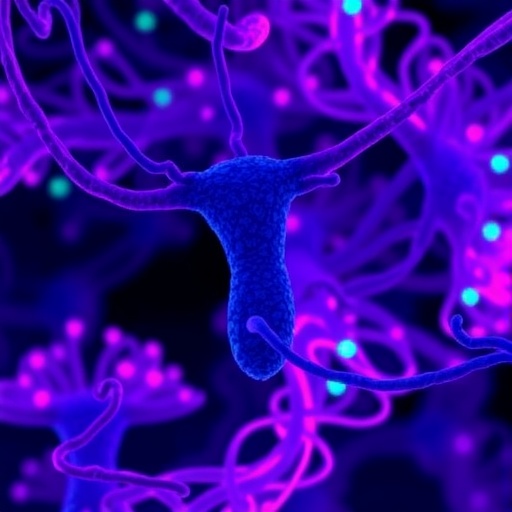In a groundbreaking study published in Nature Communications, researchers have unveiled pivotal molecular insights into polycystic ovary syndrome (PCOS), a complex endocrine disorder affecting millions of women worldwide. The team, led by Sankaranarayanan, Brewer, and Morrow, has elucidated a critical gene regulatory mechanism that underpins abnormal testosterone production, a hallmark of PCOS. Central to their findings is the gene DENND1A, whose activity appears to drive excessive androgen synthesis, offering a transformative perspective on the disease’s pathophysiology and revealing new avenues for targeted therapeutics.
Polycystic ovary syndrome, characterized by hormonal imbalances, ovulatory dysfunction, and metabolic disturbances, has long challenged the scientific community due to its enigmatic etiology. Hyperandrogenism, excessive levels of male hormones such as testosterone, exacerbates many PCOS symptoms, including infertility and metabolic syndrome. Despite extensive research, pinpointing the molecular drivers of this androgen excess has remained elusive — until now.
The study utilized cutting-edge genomic and transcriptomic profiling techniques on theca cells, specialized ovarian cells responsible for androgen production. Through integrative analysis of chromatin accessibility, transcription factor binding, and RNA expression, the investigators mapped the regulatory landscape associated with PCOS. These advanced methodologies allowed for the dissection of enhancer elements—DNA regions that enhance gene expression—from healthy and PCOS-affected theca cells.
One of the most striking discoveries is the identification of a PCOS-specific regulatory circuitry centered around the DENND1A gene locus. DENND1A encodes a guanine nucleotide exchange factor involved in vesicular trafficking and signal transduction, but its role in androgen biosynthesis was previously unclear. The team demonstrated that aberrant activation of enhancers in the DENND1A region boosts its expression, consequently elevating testosterone production in PCOS theca cells.
Functional assays corroborated the causal role of DENND1A in this augmented androgen synthesis. Silencing DENND1A using RNA interference resulted in a marked decrease in testosterone levels, confirming its direct contribution to the hyperandrogenic state. Moreover, overexpression experiments showed a dose-dependent increase in androgen output, emphasizing DENND1A’s influence as a master regulator within ovarian steroidogenesis.
At the molecular level, altered chromatin architecture was revealed to facilitate enhanced accessibility of key transcription factors, including SF1 and GATA6, at the DENND1A enhancer regions. These transcription factors are well-known orchestrators of steroidogenic gene expression, and their misregulation in PCOS theca cells appears to drive DENND1A overexpression. This finding links epigenetic modifications and gene regulatory dynamics to pathological androgen excess, highlighting how changes in the 3D genome structure can impact disease states.
Beyond the molecular mechanisms within the ovary, the study also explored systemic implications of DENND1A-mediated androgen dysregulation. Elevated testosterone levels contribute to insulin resistance and metabolic dysfunction commonly observed in PCOS patients, suggesting that DENND1A’s activity may bridge molecular pathology with broader clinical symptoms. This integrative view of gene regulation and metabolic impact offers a holistic understanding of PCOS as a multisystem disorder.
The researchers further identified specific enhancer elements within the DENND1A locus that could serve as promising therapeutic targets. Modulating these regulatory sequences with genome editing or small molecules may downregulate pathological androgen production without affecting essential gene functions elsewhere. This concept of targeting non-coding regulatory DNA marks a paradigm shift in precision medicine for endocrine disorders like PCOS.
Crucially, the study emphasizes the heterogeneity of PCOS, noting that DENND1A-dependent mechanisms may account for a distinct molecular subtype of the syndrome. This insight could refine diagnostic criteria and personalize treatment strategies, enabling clinicians to identify patients who would benefit most from DENND1A-targeted interventions. Such stratification is vital given the variable clinical presentations and treatment responses observed in PCOS.
In addition to ovarian tissue analyses, single-cell RNA sequencing further delineated cell-type specific expression patterns, confirming the enrichment of DENND1A activity predominantly in theca cells. This specificity reinforces the gene’s central role in local androgen biosynthesis rather than systemic hormone regulation and highlights the importance of studying distinct cell populations within complex tissues to understand disease mechanisms.
The integration of multi-omics datasets—including ATAC-seq, ChIP-seq, and RNA-seq—enabled the construction of comprehensive gene regulatory networks, placing DENND1A at the nexus of androgen synthesis pathways. This approach exemplifies the power of systems biology to unravel intricate regulatory circuits underlying endocrine dysfunction in PCOS and potentially other hormone-related conditions.
Importantly, these findings not only advance basic scientific knowledge but also open translational avenues. The identification of DENND1A as a driver of pathological testosterone production affords pharmaceutical development opportunities, including antisense oligonucleotides, small interfering RNAs, or epigenome-editing tools aimed at fine-tuning gene expression levels within the ovary.
This seminal work in PCOS research aligns with a broader trend toward elucidating the regulatory genome’s role in human disease. By focusing on how enhancer elements and transcription factor dynamics are reprogrammed in PCOS, the study illustrates how non-coding DNA can exert profound effects on endocrine health, expanding therapeutic horizons beyond classical protein targets.
Given the prevalence of PCOS, affecting approximately 10% of reproductive-age women globally, these insights bear immense clinical significance. Improved molecular diagnostics and targeted therapies stemming from the unraveling of DENND1A-related pathways could markedly enhance patient outcomes, mitigating infertility, metabolic disturbances, and long-term cardiovascular risks associated with the syndrome.
The authors underscore the necessity for further longitudinal studies and clinical trials to validate DENND1A-targeted treatments’ safety and efficacy. Moreover, understanding how environmental and genetic factors interact to modulate DENND1A enhancer activity could illuminate disease prevention strategies, offering hope for mitigating PCOS onset in susceptible populations.
In summary, the research conducted by Sankaranarayanan and colleagues represents a milestone in PCOS biology, spotlighting DENND1A-dependent gene regulatory activity as a critical molecular driver of hyperandrogenism. The delineation of enhancer reprogramming in theca cells not only deepens mechanistic comprehension but also sparks innovative therapeutic possibilities, potentially revolutionizing PCOS management and improving the lives of millions affected by this multifaceted disorder.
Subject of Research:
Polycystic Ovary Syndrome (PCOS) and its molecular gene regulatory mechanisms related to androgen (testosterone) production.
Article Title:
Gene regulatory activity associated with polycystic ovary syndrome revealed DENND1A-dependent testosterone production.
Article References:
Sankaranarayanan, L., Brewer, K.J., Morrow, S. et al. Gene regulatory activity associated with polycystic ovary syndrome revealed DENND1A-dependent testosterone production. Nat Commun 16, 7697 (2025). https://doi.org/10.1038/s41467-025-62884-7
Image Credits:
AI Generated




